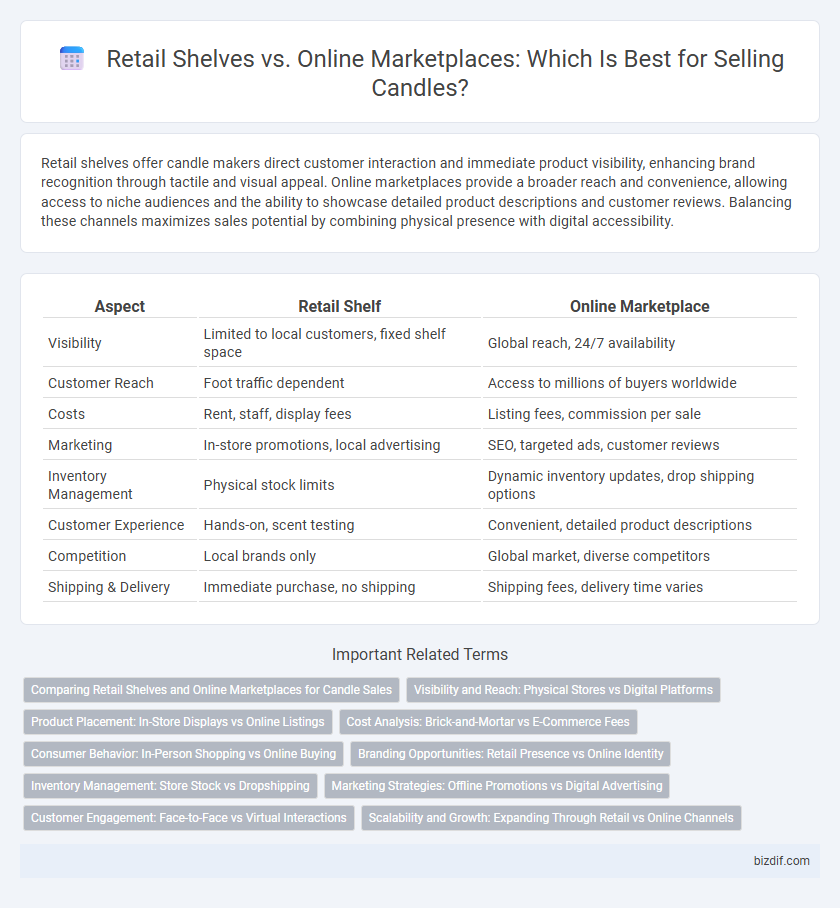Retail shelves offer candle makers direct customer interaction and immediate product visibility, enhancing brand recognition through tactile and visual appeal. Online marketplaces provide a broader reach and convenience, allowing access to niche audiences and the ability to showcase detailed product descriptions and customer reviews. Balancing these channels maximizes sales potential by combining physical presence with digital accessibility.
Table of Comparison
| Aspect | Retail Shelf | Online Marketplace |
|---|---|---|
| Visibility | Limited to local customers, fixed shelf space | Global reach, 24/7 availability |
| Customer Reach | Foot traffic dependent | Access to millions of buyers worldwide |
| Costs | Rent, staff, display fees | Listing fees, commission per sale |
| Marketing | In-store promotions, local advertising | SEO, targeted ads, customer reviews |
| Inventory Management | Physical stock limits | Dynamic inventory updates, drop shipping options |
| Customer Experience | Hands-on, scent testing | Convenient, detailed product descriptions |
| Competition | Local brands only | Global market, diverse competitors |
| Shipping & Delivery | Immediate purchase, no shipping | Shipping fees, delivery time varies |
Comparing Retail Shelves and Online Marketplaces for Candle Sales
Retail shelves offer physical visibility and immediate purchase opportunities for candles, enhancing tactile customer experience through scent testing and presentation. Online marketplaces provide extensive reach and detailed product information, leveraging customer reviews and targeted advertising to boost sales volume. Combining both channels optimizes candle brand exposure and maximizes revenue by capturing diverse consumer preferences and shopping behaviors.
Visibility and Reach: Physical Stores vs Digital Platforms
Retail shelves in physical stores offer limited visibility constrained by local foot traffic and store layouts, restricting candles to a specific geographic audience. Online marketplaces provide expansive digital platforms with global reach, utilizing SEO, targeted ads, and customer reviews to enhance product discoverability. This broader online visibility significantly increases potential sales and brand exposure beyond the confines of traditional retail environments.
Product Placement: In-Store Displays vs Online Listings
Effective product placement significantly influences candle sales, with retail shelves offering tactile in-store displays that engage customers through visual appeal and scent experience. Online marketplaces rely on optimized listings featuring high-quality images, detailed descriptions, and customer reviews to attract buyers and boost visibility. Strategic in-store positioning near complementary items and SEO-driven online keywords are crucial for maximizing product discovery and purchase intent.
Cost Analysis: Brick-and-Mortar vs E-Commerce Fees
Retail shelf costs include rent, utilities, and staff wages, significantly increasing overhead expenses for candle makers. Online marketplace fees typically involve listing charges, transaction fees averaging 5-15%, and shipping costs, resulting in lower fixed costs but variable expenses tied to sales volume. Evaluating profit margins requires weighing upfront investment in physical stores against scalable, commission-based costs in e-commerce platforms.
Consumer Behavior: In-Person Shopping vs Online Buying
Consumers shopping for candles in retail stores prioritize tactile experiences, such as scent testing and visual inspection, which strongly influence purchase decisions. Online marketplaces attract buyers through detailed product descriptions, customer reviews, and personalized recommendations, catering to convenience and broader selection. Shifts in consumer behavior show a growing preference for online purchases powered by easy access and home delivery, while in-person shopping remains favored for sensory engagement.
Branding Opportunities: Retail Presence vs Online Identity
Retail shelves offer direct brand visibility in physical stores, allowing customers to experience candle products firsthand, enhancing sensory appeal and brand trust. Online marketplaces provide extensive branding opportunities through customizable storefronts, customer reviews, and targeted digital marketing, expanding reach beyond local limitations. Balancing retail presence with a strong online identity maximizes brand exposure and drives diverse consumer engagement in the candle market.
Inventory Management: Store Stock vs Dropshipping
Retail shelves require maintaining a physical inventory, allowing immediate product availability but increasing storage costs and risks of overstock or stockouts. Online marketplaces often utilize dropshipping, reducing upfront inventory expenses and allowing a wider product range but potentially extending delivery times and complicating quality control. Efficient inventory management balances in-store stock reliability with the flexibility and scalability of dropshipping to optimize candle sales performance.
Marketing Strategies: Offline Promotions vs Digital Advertising
Retail shelf marketing relies on in-store displays, eye-catching packaging, and point-of-sale promotions to attract candle buyers, enhancing tactile product experience and impulse purchases. Online marketplace strategies leverage digital advertising through social media campaigns, influencer partnerships, and targeted ads to reach broader audiences and collect consumer data for personalized marketing. Combining offline promotions with digital analytics optimizes candle brand visibility and drives sales across multiple customer touchpoints.
Customer Engagement: Face-to-Face vs Virtual Interactions
Retail shelves in candle making offer tactile, sensory experiences, allowing customers to physically smell and inspect candles, fostering immediate emotional connections that enhance engagement and purchase confidence. Online marketplaces provide virtual interactions through detailed descriptions, customer reviews, and interactive visuals, enabling broader reach and personalized recommendations but lacking the direct sensory appeal of in-store shopping. Brands leveraging augmented reality or live-streamed demonstrations online can bridge the engagement gap by simulating face-to-face interactions and deepening customer involvement.
Scalability and Growth: Expanding Through Retail vs Online Channels
Retail shelves offer limited physical space, restricting product variety and inventory levels, which can hinder scalability and rapid growth for candle makers. Online marketplaces provide vast digital shelf space, enabling sellers to list numerous candle varieties and scale inventory rapidly to meet growing demand. Leveraging online channels facilitates broader market reach and faster expansion compared to the constraints of traditional retail distribution.
Retail shelf vs Online marketplace Infographic

 bizdif.com
bizdif.com